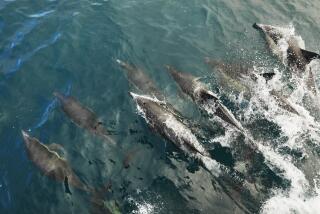What you can do to help
- Share via
Do not litter
About 80% of ocean trash comes from land, mostly fast-food wrappers and plastic bags, bottles and cups. Recycle and pick up after yourself. Bring your own bag to the supermarket.
Curb your pets
Bag dog and cat feces and dispose of them in the trash. Don’t flush cat litter down the toilet. Sewage treatment doesn’t remove parasites that can harm sea otters and dolphins.
Don’t flush medicines or solvents
Throw away unused pharmaceuticals, perfumes, industrial chemicals or solvents. Don’t dispose of them in the toilet or down the sink. Sewage treatment doesn’t remove many chemicals and dissolved drugs that can poison sea life.
Minimize fertilizer use
Don’t apply before rainstorms. Don’t use a hose to remove spills or residue from sidewalks and driveways. Sweep it up and put it in the trash.
Discard chemicals properly
Dispose of household toxins at hazardous-waste collection centers. Recycle used motor oil and transmission fluid. When possible, use nontoxic substitutes. Find the Environmental Protection Agency’s suggestions at es.epa.gov/techinfo/facts/safe-fs.html.
Collect car-wash runoff
Don’t wash cars in streets or driveways. Instead, park on lawns or go to a carwash that collects the runoff.
Buy local, buy organic
Farmers markets support local growers who drive less and are often easier on the land. Buy organic food grown without pesticides and chemical fertilizers.
Avoid over-watering
Use drip irrigation whenever possible and adjust sprinklers to minimize over-spraying. Plant hardy native plants that need less water.
Plant a tree
Trees slow runoff and absorb carbon dioxide and other nutrients that otherwise end up in the ocean.
Use alternative transportation
Consider walking, riding a bike or taking mass transit to shop or to work. Tailpipes pollute the ocean as well as the air.
— Kenneth R. Weiss
Sources: Los Angeles Stormwater Program; EPA; Heal the Bay; Natural Resources Defense Council; “50 Ways to Save the Ocean,” by David Helvarg
More to Read
Sign up for Essential California
The most important California stories and recommendations in your inbox every morning.
You may occasionally receive promotional content from the Los Angeles Times.









